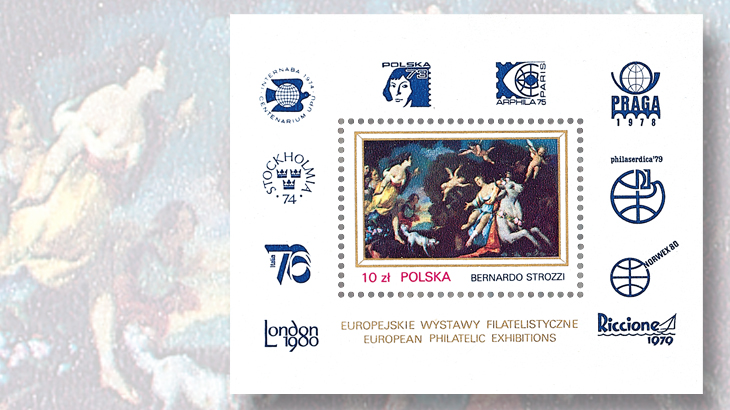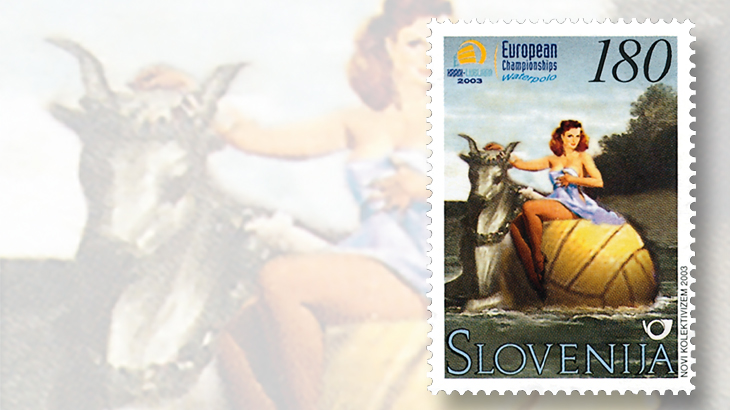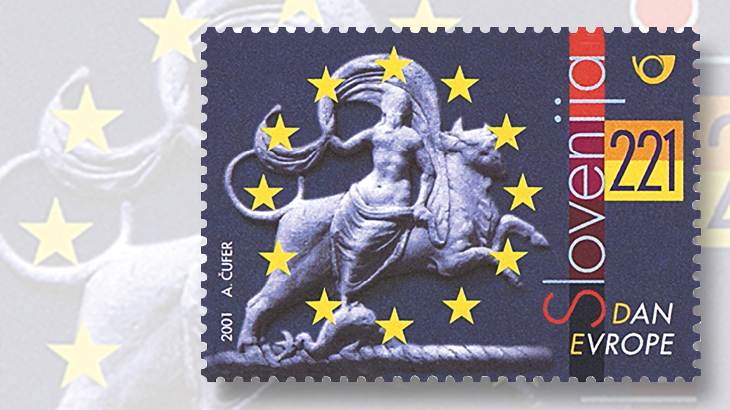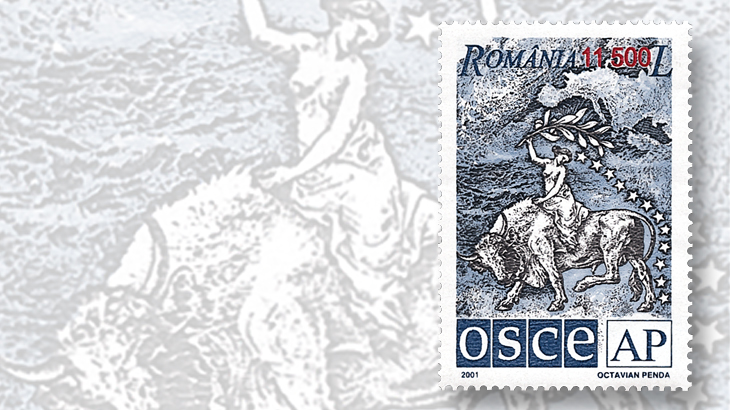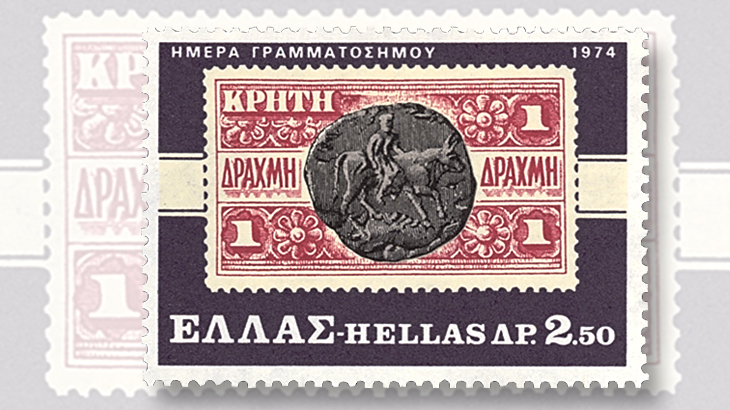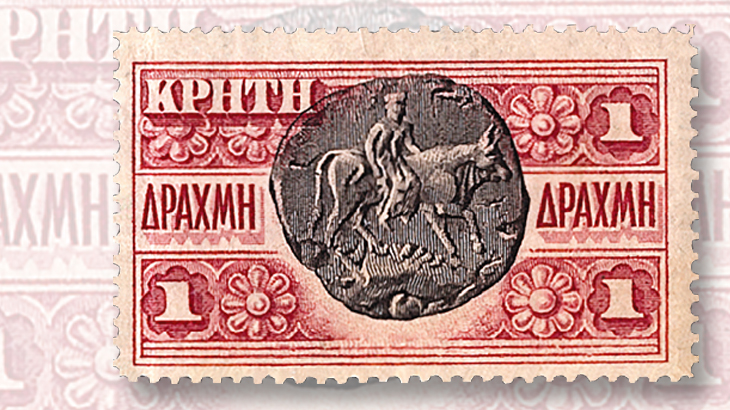World Stamps
Eastern Europe stamps highlight mythology of Europa and the bull
By Rick Miller
The continent of Europe takes its name from the Greek mythological figure of Europa. Europa was said to be Phoenician and was the daughter of the king of Tyre.
The name, Europa, has linguistic connections to “white-faced heifer,” and there are various explanations of the association between the woman and the meaning of her name.
In the mythological story, Zeus worked up a passion for Europa, and Zeus was not one to ignore his passions. Changing himself into the form of a bull, he mixed with the herd of Europa’s father. Europa was drawn to the handsome bull.
Connect with Linn’s Stamp News:
Sign up for our newsletter
Like us on Facebook
Follow us on Twitter
After caressing him, she climbed aboard for a ride, in the process getting more of a ride than she bargained for. Zeus promptly dashed into the sea with the maiden aboard and swam to the island of Crete. Once on the island, he revealed himself in his true form. Following the consummation of Zeus’s desires, he made Europa the queen of Crete, and her son by him, Minos, became the first king of Crete.
On Feb. 15, 1905, Crete issued a 1-drachma stamp (Scott 80), shown nearby, with a design based on the Cortyna coin. The design of the coin depicts the abduction of Europa by Zeus.
On Sept. 21, 1908, after the Cretan Assembly voted for union with Greece, remaining stocks of the engraved stamp perforated gauge 14 were overprinted “Hellas” (Greece) in Greek letters (Scott 92).
On Nov. 15, 1974, Greece commemorated Stamp Day with a 2.50-drachma stamp-on-stamp issue (Scott 1119) that incorporated the earlier Cretan stamp design. The stamp, shown in the second picture, was printed by lithography and perforated gauge 13½ by 13.
The Greek geographer Strabo may have been the first to give the name Europa to the continent.
By the ninth century A.D., cartographers were using Europa as the name for Charlemagne’s Carolingian Empire. The empire occupied much of western and central Europe, and Europa gradually came to be applied to the entire continent.
On Aug. 20, 1979, Poland issued a 10-zloty one-stamp souvenir sheet (Scott 2352) for the Europhil 79 international philatelic exhibition. The stamp design was based on the painting The Rape of Europa by Bernardo Strozzi.
The print run for the souvenir sheet, shown here, was 1.57 million. The souvenir sheet, printed by the photogravure process, was perforated gauge 11 by 11½ around the stamp design.
The painting used in the stamp design symbolized the pan-European nature of the exhibition. Logos and symbols of various European stamp exhibitions are shown in the selvage around the stamp.
 |
9 Important Steps to Succesfully Soak Stamps: You can get a stamp collection going with just a few things most everyone can find around their home. Sign up for our free newsletter and we'll give you instant access to our exclusive Linn's Stamp News report. |
On May 22, 2003, Slovenia used another painting of Europa and the bull on its 180-tolar stamp (Scott 526) commemorating the European Water Polo Championships. The stamp, shown nearby, was printed by lithography and perforated gauge 14.
The competition, sponsored by the Ligue Europeenne de Natation, was held at the aquatic center in Kranj, Slovenia, June 6-15, 2003. The team from Serbia and Montenegro took the gold in the final match against the Croatian team. The victory was marred by riots and fighting between Serbian and Croatian fans.
Since the establishment of the European Union, Europa and the bull has frequently been used as a symbol of that supranational grouping. Two Europe Days are observed annually in member nations and nations hoping to gain membership.
The first, held May 5, commemorates the Council of Europe, founded May 5, 1949. The second, held May 9, commemorates the European Union and marks the anniversary of the Schuman Declaration on May 9, 1950.
On that May 9, 1950, date, French Foreign Minister Robert Schuman proclaimed the union of French and German coal and steel production, the forerunner of the Common Market and the European Union. Both days are meant to honor peace and unity in Europe.
In 2001, Slovenia issued a 221t Europa and the Bull stamp (Scott 455) to commemorate Europe Day. The question of which Europe day was being commemorated was avoided by issuing the stamp on March 21 of that year. The stamp, illustrated here, was printed by lithography and perforated gauge 14.
In 2001, Romania assumed the presidency of the Organization of Security and Cooperation in Europe. To commemorate that event, on July 6, 2001, Romania issued a 11,500-lei Europa and the Bull stamp (Scott 4453). The stamp, shown in the last illustration, was printed by the photogravure process and is perforated gauge 13.
Regardless of the future of the European Union, cracks in which recently showed in the British vote to leave it, Europa and the bull will likely continue to symbolize the European continent as it has for more than two millennia.
MORE RELATED ARTICLES
Headlines
-
US Stamps
Oct 7, 2024, 3 PMMcMurtrie dismissed as APS education director following Sept. 21 arrest
-
US Stamps
Oct 7, 2024, 12 PMVasiliauskas named president of Mystic Stamp Co.
-
US Stamps
Oct 6, 2024, 5 PMApgar souvenir card available
-
US Stamps
Oct 6, 2024, 4 PMFirst Continental Congress and U.N. stamps receive Scott catalog numbers
